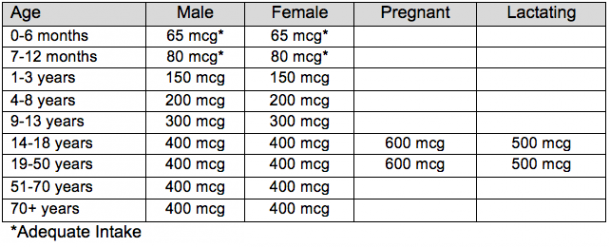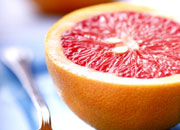 Folate and folic acid are two chemical versions of the same B-vitamin. Folate is the natural form found in foods.
Folate and folic acid are two chemical versions of the same B-vitamin. Folate is the natural form found in foods.
Folic acid, which is more stable, is used in supplements and for food fortification. The name “folate” is derived from the Latin word for leaf: “folium”, because folate is particularly abundant in green leafy vegetables.
Folate plays an essential role in enzyme reactions that control DNA metabolism and amino acid metabolism. The chemical reactions that control cell division are particularly dependent on folate, especially for cells that divide rapidly.
Compared to other B vitamins, the recommended intake of folate is small. The amounts are given in micrograms, which are just 1/1000th of a milligram.
Recommended Dietary Allowances for Folate
 Source: Office of Dietary Supplements, National Institutes of Health
Source: Office of Dietary Supplements, National Institutes of Health
Adults need to get 400 micrograms of folate per day. Pregnant women need more to support the rapid growth of the fetus, and nursing women need more for milk production.
Which Foods Have Folate?
As the name implies, there’s lots of folate in green leafy vegetables. But many other foods have significant folate content, mostly plant foods.
Kale
Chard
Beet Greens
other dark leafy greens
Romaine lettuce and other dark-colored salad greens
Asparagus
Lentils
Kidney beans
Black beans
Lima beans
White beans
Oranges and orange juice
Mango
Broccoli
Peas
The only animal food with significant folate content is liver.
Most ready-to-eat cereals are fortified with folic acid, as well as enriched flour and foods made with enriched flour.
What Happens If You Don’t Get Enough Folate?
Poor intake of folate-rich foods can lead to deficiency, but certain medications can also impair folate status. The early signs of deficiency can include a number of symptoms common to other conditions, such as loss of appetite, weakness, sore tongue, irritability and headaches.
Production of red blood cells depends on adequate folate, and a clear sign of deficiency is megaloblastic anemia: red blood cells are enlarged, and fewer of them are made.
Deficiency is linked to other problems, such as elevated blood homocysteine. Elevated levels of this amino acid are associated with increased risk for heart disease. Metabolism of homocysteine depends on folate, and improving folate intake can help lower homocysteine to normal levels.
Folate deficiency in pregnancy is associated with risk for neural tube defects, which can cause spina bifida or other severe birth defects. Pregnant women, and women considering pregnancy, should pay special attention to folate intake.


 Are you ready to look better, feel more energized, and get back that youthful feeling you remember having as a kid? I can help you on a journey that will change the way you eat — for good. My
Are you ready to look better, feel more energized, and get back that youthful feeling you remember having as a kid? I can help you on a journey that will change the way you eat — for good. My 














 As a healthy cooking expert, health coach and TV host,
As a healthy cooking expert, health coach and TV host, 



Speak Your Mind